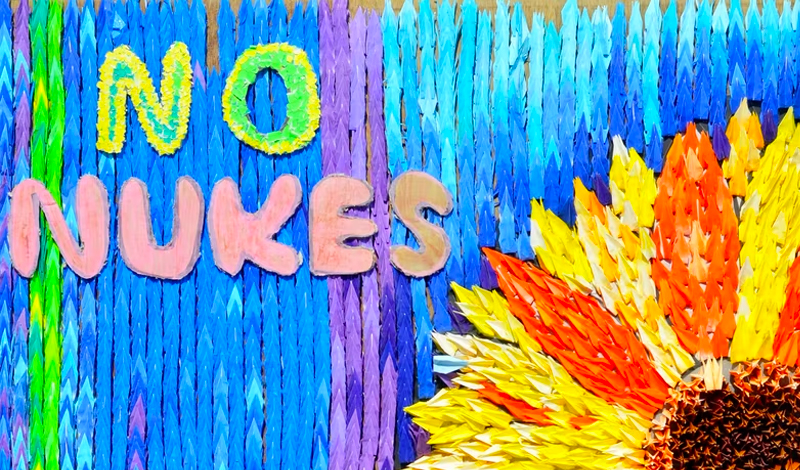It is 100 seconds to midnight, according to the Doomsday Clock, a symbol representing the prospects of a manmade global catastrophe.
The metaphorical clock had been devised in 1945 by the Bulletin of Atomic Scientists, a group that included Albert Einstein and the University of Chicago scientists who helped develop the first atomic weapons. The clock, updated annually, is a potent reminder of the perils we, as a global community, must address if we are to survive.
To be sure, movements to abolish such weapons have existed since the 1950s, reaching their peak during the Cold War, as geopolitical tensions between the Eastern and Western blocs raged on in the form of terrifying proxy wars around the globe. In the U.S., the largest show of solidarity for a nuclear weapons-free world came in June 1982, when 1 million people gathered in New York City’s Central Park to call for an end to the Cold War arms race.
Since then, such voices have waned. Young people, in particular, who were born after the Cold War, may have viewed the immediate threat as far removed from their daily lives. This, however, is changing.
In our current climate, with very real threats to world security playing out in the daily news, the need to turn the tide of public thinking is greater than ever.
But how can we, as everyday people, act on our desire for a nuclear weapons-free world?
Educate Ourselves
The best action we can take is to deepen our understanding of the imminent danger caused by nuclear weapons, help people gain an awareness of this issue and communicate our wish for the U.S. to lead other nuclear weapons states in eliminating this existential threat. Resources include:
Such efforts culminated in the Treaty on the Prohibition of Nuclear Weapons (TPNW), the first legally binding international agreement to prohibit nuclear weapons, which was ratified by 122 United Nations member states in July 2017 and entered into force in January 2021. This treaty makes the development, testing, stockpile and use of nuclear weapons illegal. Learn more at icanw.org.
· Back from the Brink is a U.S.-based coalition of individuals, elected officials and organizations (including the SGI-USA) that aims to push U.S. lawmakers to adopt policies that lead to the abolition of nuclear weapons.
This coalition works to bring communities together to advocate locally in their city or town for complete nuclear disarmament. It also hosts seminars and discussions to educate the public about the danger of nuclear weapons and connect the production and testing of nuclear weapons to other key issues such as climate change, poverty and racism. This grassroots effort aims to inspire citizens to voice their opposition to the existence of nuclear weapons to their elected officials, who can in turn help shape policies that lead to the eventual elimination of nuclear weapons.
Learn more at preventnuclearwar.org.

Creating a groundswell of public opinion is the most certain path to abolishing nuclear weapons. This action corresponds to the heart of second Soka Gakkai President Josei Toda’s injunction in September 1957 calling for the abolition of such weapons:
I hope that, as my disciples, you will inherit the declaration I am about to make today and, to the best of your ability, spread its intent throughout the world.
Although a movement to ban the testing of nuclear weapons is now underway around the world, it is my wish to attack the problem at its root, that is, to rip out the claws that are hidden in the very depths of this issue. …
We, the citizens of the world, have an inviolable right to live. Anyone who tries to jeopardize that right is a devil incarnate, a fiend, a monster.[1]
This declaration, which represents the starting point of the Soka Gakkai’s peace movement, has grown into a decades-long movement to bring attention to the threat of nuclear weapons. Ikeda Sensei, who, more than anyone, inherited the will of Mr. Toda to eradicate nuclear weapons, has written tirelessly in the form of peace proposals and editorials, and held countless dialogues with leading thinkers about this issue. In his 2018 peace proposal, he explains:
Why have I focused so single-mindedly on finding a resolution to the nuclear issue? This is because, just as Josei Toda discerned, so long as nuclear weapons exist the quest for a world of peace and human rights for all will remain elusive.[2]
Turning the tide of public opinion against nuclear weapons is our hope to create lasting changes affirming the dignity of life. As everyday people, we must believe in our ability to be the change the world wants to see. In the words of the American cultural anthropologist Margaret Mead: “Never doubt that a small group of thoughtful, committed citizens can change the world; indeed, it’s the only thing that ever has.”[3]
You are reading {{ meterCount }} of {{ meterMax }} free premium articles

